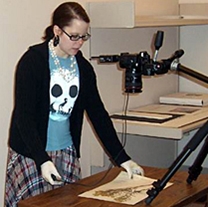Grant Spotlight | February 1, 2014
Share This
 |
|
Grantee: Butler University Grant: 2011 Grants to States (sub-award through Indiana State Library) Pictured: IUPUI Library Digital Initiatives Technician assistant, Lucy Grogg, captures an image of each herbarium sheet
|
|
Contact:
Website:
|
“Having our images available online has been of tremendous benefit to researchers around
the state, the country, and the world. They now have the ability to look at any specimen and
the associated data without having to leave their offices.”
-- Marcia Moore, Friesner Herbarium Assistant
Herbaria are collections of pressed and dried plant specimens, which are valuable for scientific and historic studies because they document the time period and distribution of local flora. Butler University in Indianapolis, Indiana, has a collection of more than 100,000 specimens in its Friesner Herbarium, over half of which were collected in Indiana. These specimens were stored in cabinets, each carefully labeled in a standard format, documenting the location and date of the collection, a description of the habitat, and the county where the plant grew.
However, public awareness about this collection was low, and individuals had to visit the herbarium to access and study the plant specimens. Resources about Indiana plant life in general were also lacking; the last book published about the entire flora of Indiana was in 1940, and it’s out of print.
Over the years, Butler students helped to a build a database with the specimens’ label information. But, it wasn’t until the herbarium found a way to shoot images of the specimens and post them online in a searchable format that the potential of this vast collection was unleashed.
Digitizing Decades of Flora
The herbarium received a grant from Indiana State Library through the IMLS Grants to States program to create a digital collection. The goal of the project, developed through a partnership between Butler University and Indiana-Purdue University Indianapolis (IUPUI), is to capture and make available online full-color digital images of Indiana plant specimens from the past and present.
Butler students – many of whom were biology majors – assisted in retrieving, packing, and filing specimens, while IUPUI provided the technology resources needed for photographing the specimens. Library science students aided in digitization, after Friesner Herbarium staff learned that one of Butler’s librarians knew how to use online database management systems that could handle the collection – just the help they needed. “Librarians are on the forefront of digitization efforts working to make information available online,” said Rebecca Dolan, Friesner Herbarium Director.
Butler Herbarium and library staff worked with students to create high-quality digital images of each specimen. These detailed, full-color scans allow students and researchers to study the features of plants while reducing handling of the fragile specimens. Visitors to the digital collection are able to utilize the images and metadata and narrow their searches by species, location, and time period.
Linking Botany, History, and Everything in Between
The project, which is still underway, has made available to the public volumes of data from fourteen of Indiana’s largest and most common plant families. In addition to facilitating access, the digitization has helped to promote awareness of the collection and appreciation of the wide diversity of plant life within the state of Indiana. Because the majority of the collecting was done from the 1920s through the 1940s, the collection serves as an important historical record.
Although the catalog hasn’t been completed yet, the project has already yielded valuable results for a variety of users. Because the information is now searchable, researchers can better use the collection to determine which species were known to grow in each county throughout the years. Local high school students studying environmental science also used the digital collection to study invasive species by tracking the spread of plants in Indiana and observing where and when they were collected, contrasting the information with another collection about rare plants.
The Friesner Herbarium also developed related materials made possible through digital records, including lesson plans for teachers to use in the classroom to study herbaria. Professional botanists conducting research through the herbarium have commented that these are the best images they have seen, and nature photographers use the collection to help identify plants they have photographed. Artists have also used it to source images for their artwork.
The collection is also a part of the Indiana Memory Project, a collaboration of Indiana libraries, museums, archives, and related cultural organizations to enable access to Indiana's unique cultural and historical heritage through a variety of digital formats and free distribution over the Internet.
The Digital Effect
Having the collection digitized allowed the herbarium to improve its curation and discover items that had been previously identified incorrectly in the database. As a separate project using the digital collection, the Friesner Herbarium is also developing an online plant atlas of county-level flora distributions so individuals can study where plants are known to grow in the state through maps and visuals.
Friesner Herbarium staff presented the institution’s process and results for digitizing its collection to peers at the Midwest CONTENTdm Users Group Meeting and the annual meeting of the Botanical Society of America, and local NPR station WFYI aired an interview of Director Rebecca Dolan discussing the project.
Compared to the herbarium’s fewer than a dozen in-person visits per year, traffic to the digital collection has exceeded 7,000 visits a month. Many researchers have commented in surveys that they discovered species that they were previously unaware had ever grown in Indiana. In the long term, the public will be better informed of plants that grow in the state. The herbarium has shown Indiana to be an interesting area floristically. With the digital collection expanding the ways available to mine and analyze the data, there is plenty to continue exploring.
